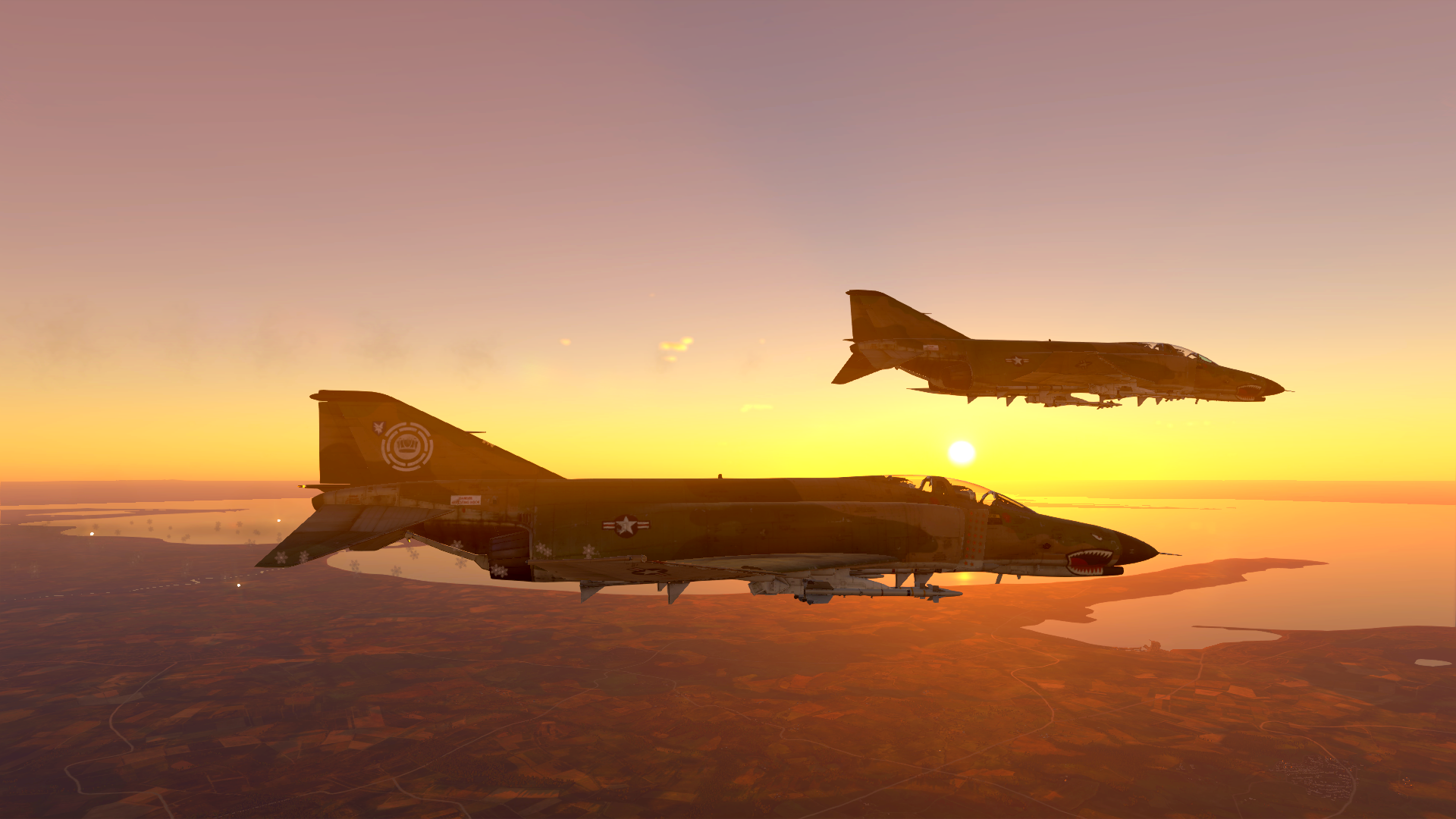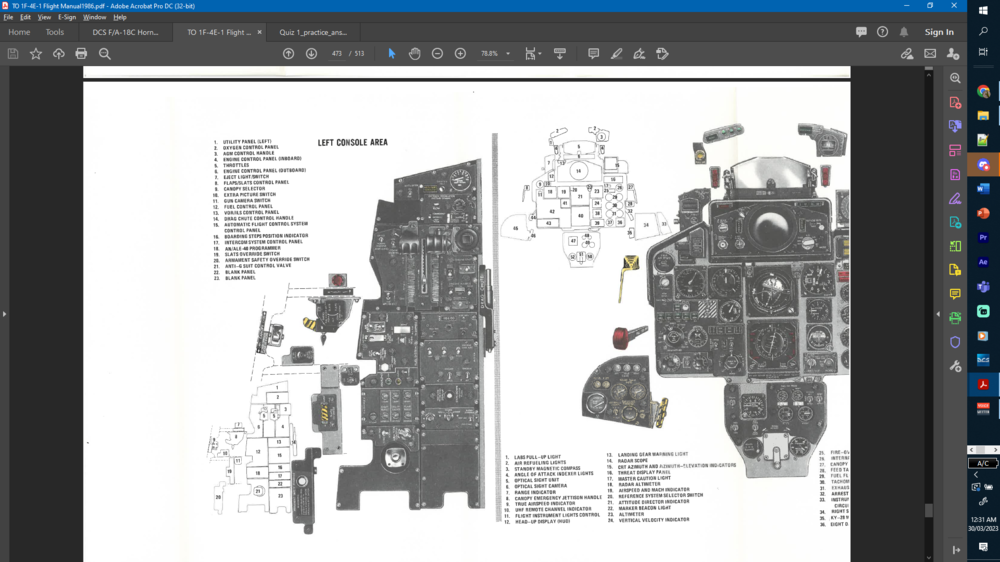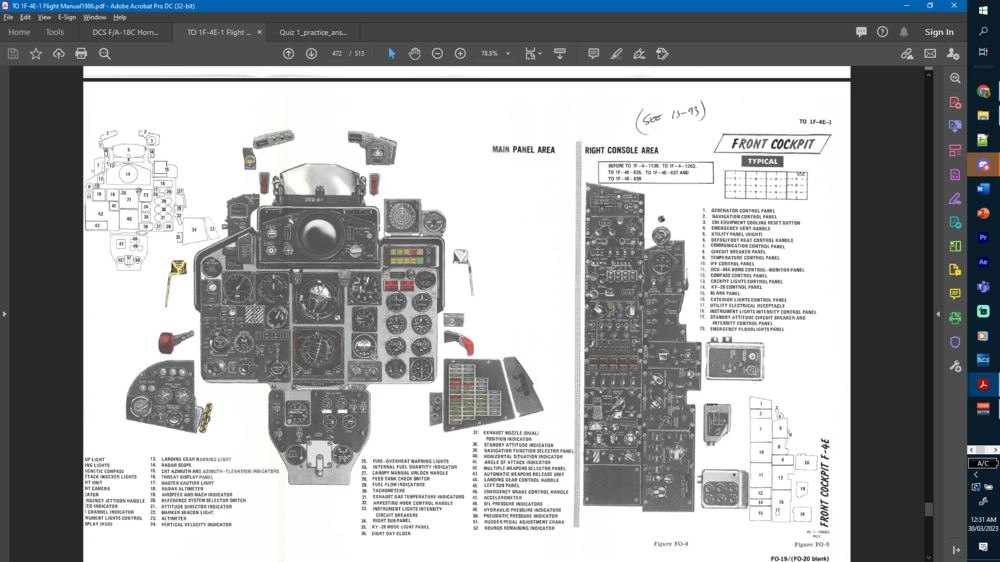-
Posts
176 -
Joined
-
Last visited
Content Type
Profiles
Forums
Events
Everything posted by Aussie_Mantis
-
Unfortunately, it's a museum piece- and I've never seen those in service at all. USN Phantoms can carry like that but that's because they have a shorter pylon than the USAF ones and different spacers, plus a MAU-12 adapter pop-out that they need to install that provides ground clearance. However, I can't find any F-4s using the payload pictured while not in a museum. Something to do with the sidewinders slapping the ends of the M117s from what I hear- which is why I wanted to pose the question about whether or not this config works IRL or not. All I've heard is that they use the Shrike adapter to further extend the TER away from the pylon. sorry to necro, but the answer to this is up to ten. Paveways only are mountable on TERs in pairs- from what I hear, it's something about the bottom rack not giving enough clearance for it to drop properly (?) (Up for debate) (possibly inaccurate). They go on all the racks and can be mounted on an MER, but typically only go on the forwards hardpoints only.
-
Hey @Elf1606688794, sorry to bother you again on an old thread- but I've a bit of a question, see, and I don't know anywhere to get an answer for this from. The F-4E can carry a TER with Sidewinders given a MAU-12 adapter and a double 3-inch spacer on inboard hardpoints 2 and 8- but when carrying this load, can it carry all 3 bombs on the TERs?
-
I'm using the F.A-18 and having an issue where if I go into map and switch back to the cockpit, my TRACKIR suddenly stops working for only the cockpit. Any idea why it's doing this?
-
I should have answered the question but you are correct- most complex tasks can't be done without the GIB. Lasing, mavericks, etc, like I've said, are all GIB stuff and you have no control over it.
-
Radar is fully rear-seat only, same goes for targeting pod and laser designation. The Mavericks I'm not sure about, but I believe the rear guy locks it and the front guy fires. Pilot has controls for having a carbon copy of what's displayed on rear seater's screen **or** switching to the 5nm ACM Boresight mode. He can fire Sidewinders, gun and sparrow using a 3-way switch on the right-hand side of the throttle. What I do remember is that you use the same switch you use for nose-wheel steering to switch from Trim to AGM-65 guidance. Switching from AA to AG is as simple as a single button press on the throttle.
-

Naval F-4 Phantom | Livery Request Thread
Aussie_Mantis replied to Zaakuro's topic in DCS: F-4E Phantom
It'd be hilarious though -

Naval F-4 Phantom | Livery Request Thread
Aussie_Mantis replied to Zaakuro's topic in DCS: F-4E Phantom
MFW They do the Phantom FG.1 as the naval Phantom instead -
Yeah, that was my point about approximate direction. SPO-10 doesn't let you see individual directions of emitters. I mean sure, if you're literally solely a Air 1v1 player then sure, fine, but in most campaigns, people tend to forget that there are more than one radar beams pointing at you at any given time. If all four emitters are going off then how do you tell where you're getting hammered from?
-
knowing an approximate direction is much better than just vaguely knowing they're between two emitters. SPO-10 is just a trash tier RWR.
-
SPO-10 has 4 direction indicators, one for each diagonal directon. SPO-15 has eight over the frontal arc plus two for the rear- one on each side. Neither give exact directions, they are limited to telling you that they are a set amount of degrees off to a certain side- in the case of SPO-10 there might as well not be any decent indi ation at all of bearing. Meanwhile, AN/APR-46 is omnidirectional, and gives you a much better bearing calculation and indication. There's a massive difference between the two in terms of accuracy and arc covered and I wouldn't hesitate to argue that every single US RWR set starting from AN/APR-25 was arguably better and more advanced than any set used on service Soviet Union aircraft.
-
after mrahc btu befour mei
-
F-4E Phantem wil be relese in aprel F 4 F is the 6th letter of the alferbit 2 * 3 = 6 2 3 = 23 2023 23rd of aprel relese Thankyou for attending my Ted Talk.
-
It provides way more. that's literally objective fact outright. The SPO-10 only provides, what- four directions? The AN/APR-46 provides pretty much every direction, and the only one it gets outright confused by is that it gets 3 clustered together when dead to the front, and even then, it's so close together that it looks like one emitter is firing anyhow. As you said, it gives you SOME indication about what it is that's been beamed at you- the strobe display at least distinguishes between X and S band radars to distinguish between ground and air (S-band is a solid line, X-band is a dotted line), and more importantly, it has a separate console next to you that at least tells you what kinds of radar are lighting you up. It might not specifically tell you which strobes they are, but the knowledge that you have X kind of radar lighting you up is very useful- especially when deciding between trying to react against a Fan Song or a Fire Can, or when you're trying to figure out what kind of plane is lighting you up. It also provides indications of strength, which soviet RWRs do not, and indications of whether it's searching or tracking.
-
I'd be fine with that, I mostly intend to fly DMAS F-4Es anyway.
-
I'm hoping it doesn't- I've tried using the strobe display in other games before. I hated every minute of it. It's useful knowing when someone's locking you but when that could be anything from a MiG-21 to an SA-2 your situational awareness is cut in half. Thankfully, I think and am pretty sure that the MiG-21 and other aircraft use X-band FCS radars, which means they'd appear as dotted lines on the RWR strobe, while solid lines would be SA-2 et cetera. The concern then becomes operating in a cluttered RWR environment. The strobe would be unique, admittedly, but looking up and down from the display to the console is going to get really annoying for me, really fast.
-
Rerailing this convo back to the F-15E's secondary air to air role, Can someone direct me to the posts where people were discussing its performance in air to air? I know the distinction is a bit more than just less gun ammo, less AoA, more thrust etc, but I'd like the details.
-
What you sent is very relevant, thanks. However, it doesn't describe the predecessor to CAA (I forgot the name) that allowed it to somewhat filter out ground clutter (though nowhere as efficiently as PD), and I'm pretty sure there were a couple of sidegrdes to the antenna that switched around how it works. I remember however that early versions of the AN/APG-120 were very bad. I think there was an expanded AutoAcquis boresight mode that went out beyond 12,500 feet??? But I'm seriously not sure about this. As I said, I will do some further research into this topic. Thanks a lot for the reports though! They're really interesting reads! Uhhhhummmm... I don't know. Maybe. maybe not. It'd be cool if we got it though. The ALphanumeric one on the F-5E is the AN/ALR-46(V)3/AN/ALR-46(V)4 (I forgot which one) and I don't know if that's within our timeframe and whether or not all of the AN/ALR-46 variants have alphanumeric coding.
-
People's opinions on South Atlantic seem to be gnerally negative and describe a general lack of polish. Is this really the case or is this a case of a vocal minority?
-
The saying is Jack of all trades, master of none, is better than master of one. I think that might apply here with the F-15. Also, the A-10 was hardly ever good at CAS, Your point however still applies. I recant.
-
IIRC The F-15C has CFTs as well, but they're far more bulky. The difference between the C and E models are very different, though, I agree. If you're acquiring 50 aircraft, you're acquiring 50 aircraft. Whether that's 20 fighters and 30 attackers or 50 multiroles plays no difference to that. Even so, I do agree that you can save in some areas, like maintenance bill, but I'd argue that it's an advantage in and of itself. Perhaps- maintaining 30 ground attack and 20 fighters to escort them is a higher cost and maintenance load than 40-50 of the same plane. But I think that even then, a multirole aircraft does shine. The F-4 was intended to do only air to air roles, but the USAF pressed it into service as their tactical bomber for the Vietnam war as well as having packages of F-4s escorted by F-4s. The A-7 and F-111 did exist, but up until the introduction of the F-15, even when defence spending was at its highest pre-Reagan, the F-4 was the workhorse of the air force. Even during the Reagan era, the F-16 was expected to do both A2G and A2A roles like the F-4 before it. The only exceptions i can think of within the teen series are F-14s and F-15s, which while predominantly air to air, were kitted out for and were sometimes used in air to ground roles (F-14A in iranian service, F-15A in Israeli service). The best example of a cold war multirole platform that I can think of are the F-16 and the F-4, which saw high use and proliferation, and saw use in A2G as well as A2A roles in all of the countries they served- the Osirak Nuclear Reactor raid was not performed by A-4N Ayits, nor F-4s, but by a formation of F-16s escorted by F-15As, and Operation Wooden Leg was conducted by F-15s escorting F-15s that both dropped bombs- however, this is an outlier, since Israel is the only force at present to have used the original fighter variants of F-15s in that role. While they did favour one role or the other, I don't think it's appropriate to really describe it as single-role. The F-15A and F-15C have the exact same range of wing pylons for attaching bombs and rockets and guns to, and that wasn't exactly due to the F-15 being multirole- there's other reasons to have big pylons, such as what the A/C mainly used their pylons for- fuel tanks. It's not like you're deliberately not going to have large pylons just because your plane is designed for air to ground combat. And the F-22 negates that completely by just storing everything internally, and the weapons bay on F-35 was designed from the outset to fit things like JDAMs. I'm not sure whether SDB was designed to fit into the F-22's bay or if the bay was designed to fit SDB, though. As for the F-22, I have nothing to say regarding that. Touche. However, I might mention that even the F-22 ultimately can and will be used in strike roles, indicating at least some consideration from the outset of multirole capability, ergo, I propose that multirole capability is a highly important aspect of an aircraft and will paly an important part in future gen 5 development. However, from a design capacity, I think that the "universal capacity" here where a fighter can essentially double as a strong attack/CAS plane with a wide range of pylons and ordnance is really an indicator of aircraft swinging more towards the multirole part of the spectrum- I can't really name any new fighter designs that are meant to be single-role. Especially with the newer gen5s, the name of the game seems to be multirole aircraft, and even with the older 4.5s, multirole was hardly an afterthought- aircraft like the EF Typhoon, which was designed to be the next aerial superiority fighter of Europe, were designed with that multirole capability in mind, and many more single-role aircraft received upgrades to perform multirole actions. It's really just easier and more convenient, as well as more potent to have a plane that does both- maybe not to the extent that you convert your plane into a strike fighter a la F-15A to F-15E, but at least from, say, F-14A to F-14B/D plus bombs, or from early Typhoons fitted for but not with targeting pods and later with that capability integrated in. You are, ultimately, right, though. I highly doubt that it was intentional at the start- it probably was easier to just strap stuff to planes at that point. But I think the point does stand that most fighter development programs sell multirole capability as a plus, because at this point we can develop air to ground capability in an aircraft without sacrificing air to air capability.
-
Dedicating them to do multiple roles and cross train would be more expensive, wouldn't it? That doesn't make sense. Training them on a single role and only having to maintain flight hours necessary for a single role is less expensive than training for multiple roles. Also, it's not necessarily like that. You get taught multiple things at school but you can be better at one subject and trash at another, but you're expected to maintain competency across a wide variety of roles and excel at them as well. Most air forces don't teach you to fly only one mission profile, they train you to fly them all. The Iraqi Air Force in '91 was a crack, single-role but highly combat-experienced arm of highly motivated pilots. They lost to multirole pilots who didn't have a lick of combat experience. "Single-Role is Better than Multirole" is a mentality that died the moment planes started to be able to become highly maneuverable and large enough to carry an appreciable payload- arguably with the F-4 Phantom, in my opinion.
-
I don't think Korea, Qatar, Singapore and Saudi Arabia classify as countries that can't afford to have single-role squadrons. Also, at that rate, then why does the US bother with making multirole aircraft? Every major US aerial platform is a versatile multirole weapons platform. Every modern 21st century aircraft is a multirole platform, and the effectiveness of a good multirole platform has been proven in nearly every single major conflict to date from Vietnam 'til now, most particularly in the Gulf. It's not just that it's a "can't afford" thing. On a cost-for-cost basis, a single-role fighter is cheaper than a multirole platform- the F-15C is a few million dollars cheaper than an F-15E. It's more affordable on a purely cost basis to just buy single-role aircraft, such as a cheap strike aircraft plus a single-role air to air platform. The thing is that multirole aircraft are straight up just better than a single-role aircraft for any given role. It's not like how in games there's a sacrifice of one thing for the gain of another; more often than not in The Real Worldtm it's a gain of capabilities for no real loss. Sure, there are some savings across the fleet as a whole for making them multirole, but there's also just the versatility as a whole. An A-10 or A-7 that ditches its load due to enemy action is that, an A-10 or an A-7. An F-16 assigned to a strike mission that ditches its load is an F-16, now minus a few tons of payload.
-
The debate on the F-15E's 'secondary' air to air role feels like people when they delude themselves into believing the F-4 was a "bomber" first and a dogfighter "second", because they're convinced that it wasn't able to dogfight at all. In the case of the F-4, training was what mattered most. It had the performance to kick the ass of any contemporary MiG-21. In the case of the F-15E, I might note that most of the export F-15s, which are expected to fill A2G and A2A roles, and are equipped with things such as IRST and the like, are all derivatives or variants there-of of the E-model. The F-15A/C never really saw the export success that the E-models did later on. The A/C models went to Japan (license-production), Saudi Arabia, and Israel. The Sauds and Israelis evidently decided buying more twin-seater F-15s was a better idea, while Singapore, Qatar and South Korea, when offered with the single-seat version, decided buying the twin-seaters were better. The Aussies (that's us!) decided that between the single-seat, air-to-air only F-15 versus the "inferior", multirole F/A-18A, the F/A-18A was the better horse to bet on. I think we're giving the F-15E too much flak. It's got ~6000lbs more of thrust dry and only 2000lbs more empty weight, so I think something's probably up.
-

Any HERO would make a HUD mod for the F-4 :D
Aussie_Mantis replied to 1130's topic in DCS: F-4E Phantom
@1130Thought of this afterwards but was working & didn't have time to post- If you really want to familiarize yourself, start gettingnull to know the cockpit layout. Here's two images to get you started: nullthey'renull meant to be one fold-out, so use photoshop ro something to crop them into place! -
I will make one.





